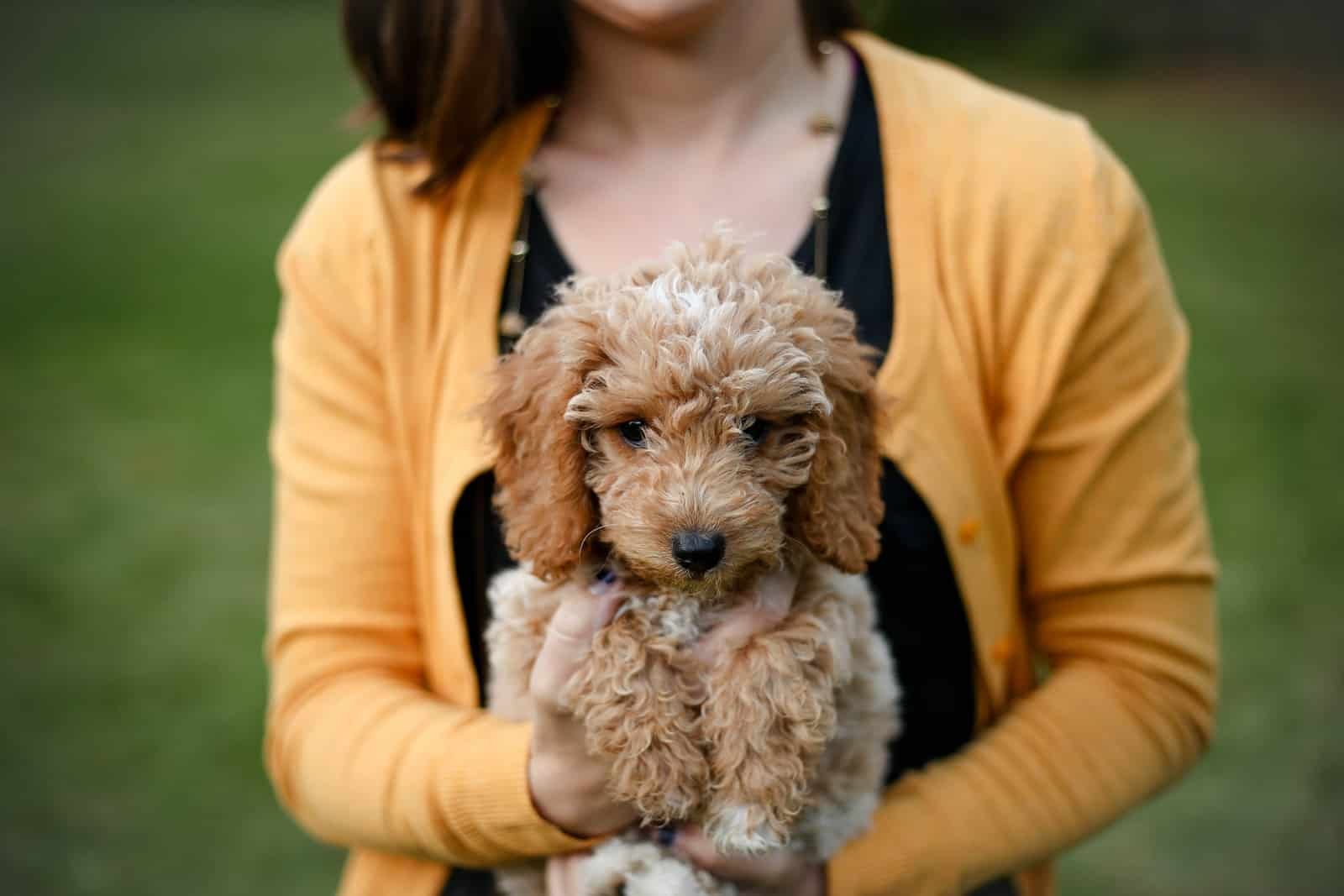
Are Poodles Hypoallergenic?
If you’re allergic to dogs but are looking for a furry friend to call your own, you may be looking for a hypoallergenic breed. You may also have heard that poodles are one of the most hypoallergenic breeds around. In this article, we’ll help answer the “are poodles hypoallergenic?” question.
About This Guide
- Real Experience: Written by poodle enthusiasts with years of hands-on experience caring for and training poodles.
- Expert Reviewed: Content verified by certified dog trainers and veterinary professionals.
- Fact-Checked: Information sourced from the AKC, veterinary journals, and breed specialists.
- Last Updated: November 2025
How Common Are Dog Allergies?
While it’s difficult to determine how many people are allergic to dogs, it’s estimated that 30% of Americans have pet allergies to cats and dogs. And with roughly 65% of American households having a domestic animal, some people don’t discover their allergy until after adding a pet to their home. In many people, symptoms of an allergy to dogs look like symptoms of most environmental allergies you may experience sneezing, a runny nose, congestion, a cough, postnasal drip, and itchy or watery eyes.
Related Reading: Adopt Hypoallergenic Poodles – Allergy-Friendly Dog Guide
Some people who are allergic to dogs may also develop allergic dermatitis, a skin reaction caused by direct exposure to the offending allergens. Allergic dermatitis may cause hives, which are raised, red skin patches. It also may cause itchy skin or eczema.
For people living with asthma who are also allergic to dogs, symptoms may become dangerous. Chest tightness, shortness of breath, and/or asthma attacks may occur. If the asthma attack is severe enough, it may require emergency medical care.
If you have children, you can help reduce risk of developing dog allergies. There’s some evidence to suggest that raising a child with multiple pets in the home during the first year of life may reduce their risk of developing pet allergies.
What’s a Hypoallergenic Dog Breed?
All dogs produce allergens. However, dogs categorized as “hypoallergenic” tend to have fewer allergens (more on this in the next section). Typically, if you see a dog breed described as hypoallergenic, it means that the dog has a low-dander coat or sheds less often than other species.
Dogs also produce allergens in their saliva, so some hypoallergenic breeds drool less than others. By keeping your environment as saliva-free as possible, you can reduce your risk of having an allergy attack or unpleasant allergy symptoms. To be completely allergen-free, a dog would need to have a mutation of can f 1, the primary dog-produced protein that triggers allergy symptoms in those with a sensitivity. A mutation in the protein may render the allergen harmless to humans.
We know this because an allergy company called Allerca has discovered a line of virtually hypoallergenic cats. These cats have a mutation in Fel d 1, the most common allergen found in cats. This mutation was naturally occurring, and a similar transformation may one day appear in dogs. However, no research has found one yet. You might wonder if hairless (or nearly hairless) dog breeds like the Peruvian Hairless Dog or the Chinese Crested are entirely hypoallergenic and therefore better for people with allergies. It’s easy to see why plenty of people think this after all, a hairless dog has less dander. However, these breeds still exude pet allergens through their skin and saliva, and they may even cause allergic symptoms. After all, dander is the main culprit when it comes to spreading allergens. Dander refers to dead skin cells. It can apply more efficiently when a dog with hair sheds, but it can spread through your home even if you have a hairless dog.
Poodles are considered to be Hypoallergenic.
Poodles are frequently referred to as being hypoallergenic. And while we now know that there’s no such thing as a completely hypoallergenic dog, poodles are thought to be less disruptive to allergy sufferers.
You may have heard breeders or owners praise a particular mixed breed like the Goldendoodle (Golden retriever/poodle mix) or the Labradoodle (Labrador retriever/poodle mix) as hypoallergenic. After all, if poodles are believed to cause fewer allergic reactions under their non-shedding coats, it seems logical that a poodle mix would be the same way. When asking, “are poodle mixes hypoallergenic?” it’s important to remember that the main reason poodles are considered hypoallergenic is because their unique, curly coat sheds much less than the skins of other breeds. Thus, just how hypoallergenic a poodle mix is will depend mainly on the coat type, and there are a wide variety of mixes to choose from. If you’re selecting a puppy, be sure to look for one with a poodle’s signature curly coat. If the puppy’s skin looks more like that of the non-poodle parent, it may be more likely to spread allergens around your home.
Essentially, when looking for a hypoallergenic poodle mix, you’ll want to make sure you’re looking for a dog that is more poodle-like than not.
They Don’t Shed as Much
While most harmful dog allergens are concentrated dander, coats that shed frequently make it easier to disperse dander. Popular breeds, like Poodles, are almost non-shedding breeds and regular grooming will help reduce potential issues. This may surprise you, but a poodle’s soft coat is more like hair than fur. A poodle’s coat will continue to grow, which is why these dogs need frequent trims and grooming. While trips to the groomers may be time-consuming, it’s a small price to pay if you can have a dog that doesn’t trigger your allergy symptoms. And as a bonus, those frequent groomings help keep dander to a minimum.
They Rarely Drool
Most people don’t like it when a dog drools on them, but dog drool can be especially harmful if you’re allergic to dogs. While dander is the primary vessel for allergens, saliva also carries a significant amount of allergy-causing proteins. Even if a dog doesn’t drool directly on you, dried saliva can become airborne, and allergy-causing particles can reach your eyes or lungs.
Luckily, poodles aren’t a breed that’s known for drooling, so you’ll be relatively safer with a poodle than you would with a pug or a bloodhound (both species that are known to drool). And as a bonus, poodles are an intelligent breed. You may not think this has to do with allergens. However, smart dogs are easy to train, so your poodle can quickly learn not to lick you or not lie down on your bed. This may reduce your exposure to any allergens they produce.
They Produce Little Dander
Most dogs have a dual-layer coat. This can help keep them warm in cold climates, but it’s a disadvantage for owners with allergies. These thicker coats are more associated with high amounts of dander. Thicker coats can also trap dust, which more often than not contains additional allergens. Of course, no poodle is completely dander-free, but they produce less of it than other breeds.
Can Poodles Still Cause Allergic Reactions?
While conventional wisdom seems to hold that poodles are one of the least allergenic breeds around, there’s some evidence to the contrary.
A 2012 study investigated whether dogs commonly called “hypoallergenic” were truly safer for allergy sufferers.
The researchers tested the hair and coat samples from species considered hypoallergenic to evaluate these breeds and those thought not to be. They were looking for concentrations of Can f 1, the primary dog allergen. The results were surprising. They found that the concentrations of Can f1 were highest in breeds considered hypoallergenic. Poodles had the highest amount of Can f 1 in their coats. This suggests that poodles are not nearly as hypoallergenic as many people think they are.
How Can You Minimize Your Risk of an Allergic Reaction?
No dog is 100% guaranteed not to cause an allergic reaction. But if you’re a dog lover, you’re probably willing to take some steps to reduce your risk of allergic symptoms. Here are things you can do to keep yourself healthy and your dog happy:
Verify That You Have a Dog Allergy
If you get a dog and develop symptoms after, it’s a good idea to make sure that your symptoms are indeed from the dog. If you talk to your doctor or an allergist, they may be able to arrange allergy testing for you. If you do have an actual allergy to dog dander, you can then take steps to manage that allergy. And if you don’t have a dander allergy, you’ll likely want to get to the real root of your allergic symptoms.
Clean Your Home (and the Air)
Dander and saliva can easily become airborne and spread quickly throughout your home. To prevent allergens from accumulating, you’ll want to make sure you thoroughly clean regularly. Be sure to vacuum, mop floors, and wash rugs, pillows, and bedding.
To combat airborne dog allergens, you may also want to invest in HEPA (High-Efficiency Particulate Air) filters. HEPA filters can remove tiny allergy-causing particles from the air. Most filters have near-silent settings, so excess noise shouldn’t be a concern.
Designate a Dog-Free Zone
To minimize your exposure to allergens, it’s a good idea to pick a spot in your house where the family dog is not allowed to go. Ideally, this would be your bedroom. By avoiding breathing in allergens as you sleep, you’re more likely to stay healthy.
Hand Washing After Contact With Your Dog
Each time you touch your dog, you’ll transfer some dander to your skin. If that dander stays on your skin, you increase your risk of allergic dermatitis and other allergic reactions. This may be a tricky habit to keep, but it’s worth it you’ll spend more time with your pet, and you also can protect yourself from having an allergic reaction.
Final Thoughts
Even though research may not support it, many dog owners with allergies have found that poodles are a better choice for people since any issue is pretty minimum and manageable. With their virtually non-shedding coats, moderate amount of drool, and trainability, poodles can be brilliant companions for owners suffering from dog allergies. By taking precautions around the house and grooming your dog regularly, you can have a happy life with your pet, even with an allergy.






